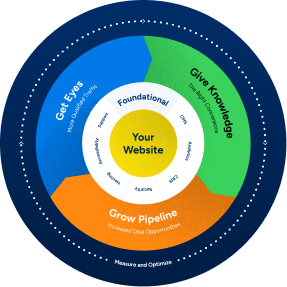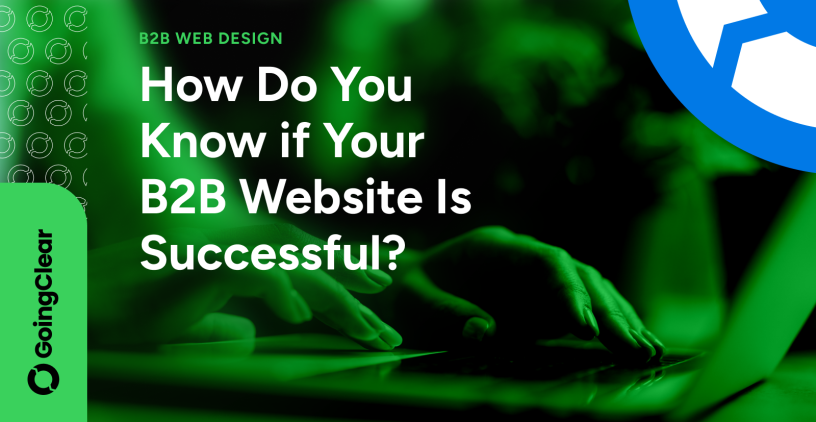B2B website success is surprisingly hard to pin down. Even though we work with a lot of profitable and growing companies, many of their CEOs and marketing directors admit to having confusion when it comes to the effectiveness of their web strategies. Should they be measuring progress in terms of design, impressions, marketing results, or something else?
There is a lot to unpack in the simple question of whether your website is working or not. So, I want to use today’s post to clear up some of the issues you might have on your mind. Then, I will provide a handful of benchmarks that might make it easier to move forward with confidence.
Let’s start with the first question you should be asking.
Which B2B Website Metrics Actually Matter to You?
To achieve success you first have to define it. That’s because “winning” doesn’t look the same for every company, or for every website. The results that move your business forward might not be applicable in another area or industry.
However, because B2B tech projects are our specialty – and because most of the metrics we use are relevant in other settings – I’m going to share a handful of progress indicators we rely on. None of them is complicated, and they are all based on real-world case studies.
Years ago, I started analyzing our most successful project. Then, I used what I had figured out to reverse engineer profits. If you want to know more about this process you should check out my book. In it, I teach you how to Get Eyes, Give Knowledge, and Grow Your Pipeline.
For the moment, though, just know that the success markers I’m pointing you toward are the ones that take you from where you are now to a pipeline full of qualified sales opportunities later. Let’s begin with the first sign that your B2B website design has been successful.
Measuring B2B Website Success the Right Way
When we talk with our clients about their current or future B2B websites, we narrow things down into a handful of distinct areas. Let’s take them one by one…
Does Your Website Function the Way It’s Supposed To?
If your goal is to generate some kind of measurable business results from your website, then it stands that the website itself needs to be functional. Functionality can take a lot of forms, of course, but we could boil it down to simple questions like:
- Do all of your pages and content blocks display correctly?
- Is your website accessible on all devices, and for those with disabilities?
- Do your pages load quickly and without errors?
- Does your website score highly (i.e., between 90% and 100%) on Google speed tests?
Of course, we look for a lot of other factors as well. Still, a healthy and functional website is usually going to perform strongly against these measures. And conversely, a website with structural problems will often perform poorly in one or more of these categories.
Do You Have Traffic Coming to Your B2B Website?
Regardless of how well it is or isn’t designed and programmed, your website needs visits from live humans in order to make an impact on your bottom line. In some cases this will involve ranking well on search engines; in other situations you might be drawing visits from email, paid ads, or even social media.
It’s worth noting, as well, that you aren’t only looking for raw numbers when it comes to website visits. It’s crucial that you have the right eyeballs reaching your content. Otherwise, you’ll get lots of empty traffic statistics without generating conversions.
In fact, that leads us beautifully to the next question.
Are Website Visits Generating Engagement of Some Kind?
When it comes to B2B website success, engagement is a better indicator than traffic. In other words, you need people to visit your pages. But it’s even more important those people spend time on your website, view multiple pages, and generate conversions.
Many executives and marketing experts think that “engagement” has to equal “lead generation.” That’s the ultimate goal, of course, but it’s also helpful if visitors are commenting on posts, bookmarking your content, sharing links with others, and using tools like interactive demos or calculators. All of these demonstrate interest and nurture familiarity.
Of course, with the right forms of engagement and a strong call to action, you should be turning website visits into sales opportunities.
Is Your B2B Website Delivering Leads?
In our world, inbound B2B lead generation is the ultimate sign of success. If you start each week or month with qualified sales opportunities that have come to you through your website, then things are moving in the right direction.
Sometimes, our clients think in terms of marketing qualified leads (or MQLs). These are people who might engage with the right content or offers and enter the sales funnel for further nurturing. In other circumstances, you might be looking for sales qualified leads (or SQLs). These individuals have raised their hand, metaphorically speaking, to speak to your sales team or book a demo.
The exact method you use to count your leads isn’t important. What does matter is that your website is helping you create those opportunities, and that some measurable percentage of them are turning into revenue.
Reverse Engineering Profits (i.e., B2B Web Design Success)
This is a good time to reiterate the point I started with. If you follow the metrics I’ve laid out in reverse order then you essentially reverse engineer success via B2B website metrics. Ultimately you’re looking for new sales opportunities. To get those you have to have engagement on your website. You can’t get engagement without website visits, and no one will visit your website unless it’s functional and useful.
None of this is complicated, but missing out on any part of the formula can cause you enormous headaches and expenses. That’s why everything we do – and all we teach – is about helping our clients follow what we call the G3 System: Get Eyes, Give Knowledge, and Grow Your Pipeline.
If you want to know more about this process you could check out my book on Amazon. Or, follow the link below to get more detail about our work. If it looks like a good fit for what your business needs, you can even contact us to set up a free consultation.
Either way, though, start thinking about what B2B website success means for your business in 2024. Then make a plan to achieve it, and don’t stop until you’re getting the kind of results you need to move your company forward.
The Ultimate Guide to B2B Web Design
Check out the Ultimate Guide to B2B Web Design and download our checklist!

